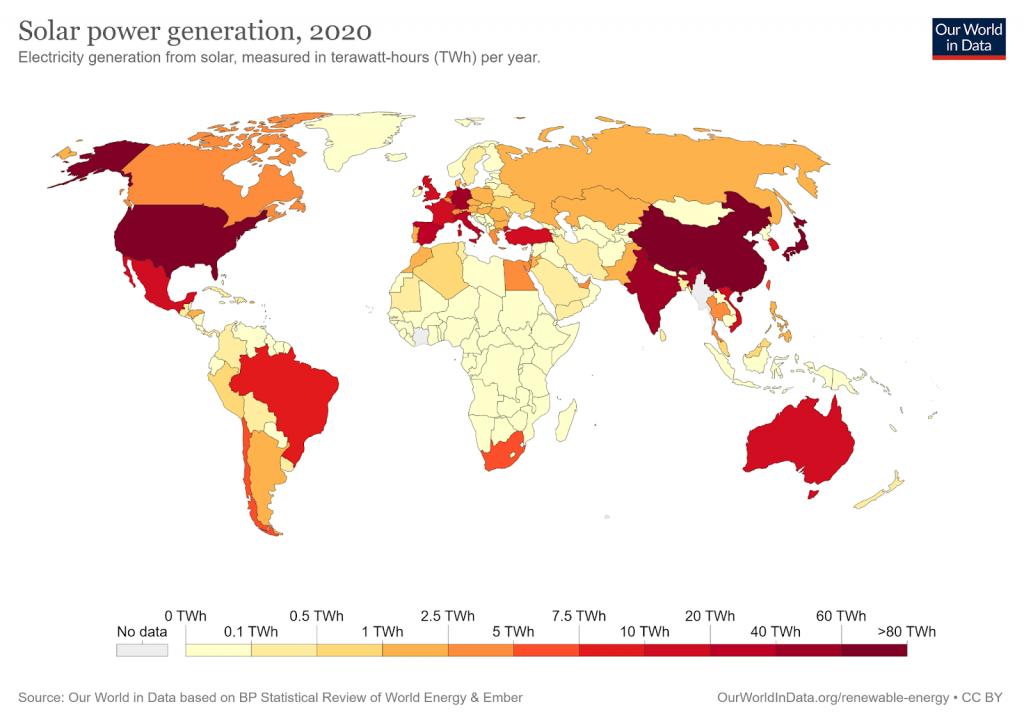What Is the Carbon Footprint of Solar Energy? A Life-Cycle Assessment
Impactful Ninja is reader-supported. When you buy through links on our site, we may earn an affiliate commission.
Learn more
Learn more
.
Hey fellow impactful ninja ? You may have noticed that Impactful Ninja is all about providing helpful information to make a positive impact on the world and society. And that we love to link back to where we found all the information for each of our posts. Most of these links are informational-based for you to check out their primary sources with one click. But some of these links are so-called "affiliate links" to products that we recommend. First and foremost, because we believe that they add value to you. For example, when we wrote a post about the environmental impact of long showers, we came across an EPA recommendation to use WaterSense showerheads. So we linked to where you can find them. Or, for many of our posts, we also link to our favorite books on that topic so that you can get a much more holistic overview than one single blog post could provide. And when there is an affiliate program for these products, we sign up for it. For example, as Amazon Associates, we earn from qualifying purchases. First, and most importantly, we still only recommend products that we believe add value for you. When you buy something through one of our affiliate links, we may earn a small commission - but at no additional costs to you. And when you buy something through a link that is not an affiliate link, we won’t receive any commission but we’ll still be happy to have helped you. When we find products that we believe add value to you and the seller has an affiliate program, we sign up for it. When you buy something through one of our affiliate links, we may earn a small commission (at no extra costs to you). And at this point in time, all money is reinvested in sharing the most helpful content with you. This includes all operating costs for running this site and the content creation itself. You may have noticed by the way Impactful Ninja is operated that money is not the driving factor behind it. It is a passion project of mine and I love to share helpful information with you to make a positive impact on the world and society. However, it's a project in that I invest a lot of time and also quite some money. Eventually, my dream is to one day turn this passion project into my full-time job and provide even more helpful information. But that's still a long time to go. Stay impactful,Affiliate Disclosure
Why do we add these product links?
What do these affiliate links mean for you?
What do these affiliate links mean for us?
What does this mean for me personally?
![]()
Solar energy is one of the most in-demand renewable energy sources that converts energy from the sun into electricity. And thanks to this harvesting of solar radiation, it also comes with low levels of greenhouse gas (GHG) emissions. So we had to ask: What is the carbon footprint of solar energy?
Solar energy has one of the lowest carbon footprints. On a life-cycle basis, concentrated solar emits 38, PV roof solar emits 41, and PV utility solar energy emits 48 grams of CO2 equivalent per kWh of electricity produced. Solar helps combat climate change and has various environmental benefits.
Solar energy makes up an ever-growing amount of total energy consumption and plays a vital role in combatting climate change. Keep reading to learn about the overall carbon footprint of solar energy, its carbon footprint throughout its life-cycle, and its environmental impact.
How is Solar Energy Defined
Solar energy is the conversion of sunlight into electrical energy either through the use of photovoltaic (PV) panels or solar radiation concentrating mirrors. The energy produced is then used to generate electricity or can be stored in batteries or thermal storage for use at a later time.
“Solar Energy: energy that uses the power of the sun to produce electricity”
Cambridge Dictionary
The amount and availability of sunlight varies by location and time of day and is called. And the amount of solar radiation a surface receives in a designated amount of time – called insolation – is influenced by latitude, climate, and weather patterns. Lower latitudes and dry climates generally have higher amounts of insolation whereas higher latitudes and wet climates have lower amounts of insolation.
Harnessing the power of the sun falls into two main categories:
- Photovoltaic (PV) solar cells: photovoltaic cells in solar panels absorb energy from sunlight, creating an electrical charge. This charge moves in response to an internal electric field in the cell, causing electricity to flow.
- Concentrating solar thermal plants (CSP): mirrors reflect and concentrate sunlight onto receivers that collect and convert solar energy into heat. This is utilized in very large power plants.
Both systems take the energy from the sun and convert it to electricity, just by slightly different mechanisms.
There are three main types of PV solar cells:
- Silicon: The most common material used in solar panels today because silicon is reasonably priced and efficient in converting sunlight directly to electricity. These panels are typically assembled on roofs of homes and buildings or are mounted en masse on racks for large-scale electricity generation.
- Thin Film: These solar panels are made of very thin layers, several millionths of a meter, of semiconductor materials including cadmium, telluride, or copper. This technology is commonly used in portable applications (i.e. backpacks, windows) because it is lightweight and flexible.
- III-V Solar Cells: These solar panels are generally much more expensive but also have much higher efficiency. They are made from periodic table Group III elements (gallium and indium) or Group V elements (arsenic and antimony). This technology is commonly used on satellites, unmanned aerial vehicles, and applications with a high power-to-weight ratio.
A group of PV solar panels clustered together forms a PV solar power plant. The largest PV solar power plant in the world is the Huanghe Hydropower Hainan Solar Park located in the Qinghai province of China. It has a capacity of 2.2 GW and 202.8 MW hours of storage capacity.
There are also three main types of concentrating solar thermal power plants:
- Linear: U-shaped mirrors focus sunlight onto tubes that span the length of the mirrors. The sunlight heats the fluid contained within the tubes, which is then sent to a heat exchanger. The heat boils water to produce steam, which spins a turbine and powers a generator to produce electricity. The two types of linear plants are parabolic trough systems and linear Fresnel reflector systems.
- Dish/Engine: A mirrored dish, similar to a very large satellite dish, contains many flat mirrors formed into a dish shape. The dish focuses and concentrates sunlight onto a receiver which absorbs and collects the heat, transferring it to an engine generator. The fluid heated by the receiver moves pistons in the most common engine, the Stirling engine. This mechanical power powers a generator to produce electricity.
- Power Tower: Heliostats, sun-tracking mirrors, reflect and concentrate sunlight onto a receiver that sits on top of a tower. The sunlight can be concentrated as much as 1,500 times. Water is most often used as the heat-transfer fluid which boils water to produce steam, spins a turbine, and powers a generator to produce electricity.
The largest solar power plant in the world is the Bhadla Solar Park in Rajasthan’s Jodhpur district, a state in India. It spans 14,000 acres and has a 2,250 GW capacity.
What is the Carbon Footprint of Solar Energy
The carbon footprint is one of the ways we measure the effects of human-induced global climate change. It primarily focuses on the greenhouse gas (GHG) emissions associated with consumption and includes other emissions such as methane (CH4), nitrous oxide, and chlorofluorocarbons (CFCs).
“Carbon footprint: the amount of greenhouse gases and specifically carbon dioxide emitted by something (such as a person’s activities or a product’s manufacture and transport) during a given period”
Merriam Webster
Basically, it is the amount of carbon emitted by an activity or an organization. This includes GHG emissions from fuel that we burn directly (e.g., heating a home, driving a car) and GHG emissions from manufacturing the products that we use (e.g., power plants, factories, and landfills).
What Is the Overall Carbon Footprint of Solar Energy
On a life-cycle basis, concentrated solar energy emits 38, PV roof solar energy emits 41, and PV utility solar energy emits 48 grams of CO2 equivalent per kWh of electricity produced.

Global solar energy demand has grown exponentially in the past decade, increasing from 51 GW in 2015 to 127 GW in 2020. Initially, European countries drove solar growth. But with decreasing costs and technological improvements, China, the US, India, and Japan entered the market.

The five largest solar energy-producing countries (amount per year) in the world are:
- China – 205 gigawatts (GW)
- United States – 76 GW
- Japan – 63 GW
- Germany – 49 GW
- India – 38 GW
Enough sunlight strikes the surface of the earth in an hour and a half to account for the world’s energy consumption in a year. Because solar energy has such a large electricity generation potential, it is important to understand what its carbon footprint is. And how its carbon emissions affect the global climate change process.
To understand the carbon footprint of solar energy, we must assess its life-cycle and each stage’s carbon footprint. This life-cycle assessment (LCA) is a method to evaluate the environmental impacts of products and materials. Over the years, companies have strategically used LCA to research and create more sustainable products. So, let’s have a look at the LCA of solar energy!
| The life-cycle stages of solar energy | Each stage’s carbon footprint |
| Building of solar energy | CO2 emissions from the construction of solar power plants and electricity delivery mechanism |
| Operating of solar energy | Little to no CO2 emissions or waste products |
| Building back of solar energy | CO2 emissions from decommissioning the solar farms and land restoration |
The total carbon footprint of solar energy would equal the carbon footprint from building + the carbon footprint from operating + the carbon footprint from building back.
What Is the Carbon Footprint of Building Solar Energy
CO2 emissions at this stage occur upon the construction of the solar power plants and electricity delivery mechanism.
Many components are required to construct a solar power plant, and building these components requires machinery that emits CO2. The mirrors, heat-exchange fluid, receivers, engines, turbines, and generators as well as the transmission lines, transformers, and substations required for delivering electricity to consumers all have a carbon footprint.
What Is the Carbon Footprint of Operating Solar Energy
Solar energy operates differently depending on the type of solar power plant (i.e. PV or concentrating).
PV solar power plants operate in the following way:
- Sunlight strikes a PV solar panel, creating an electrical charge
- The charge moves in response to an internal electric field in the cell, causing electricity to flow
The electricity is then transported to a substation where it is transmitted to consumers by transmission lines. Transformers receive the electricity and either increase or decrease the voltage as needed before it can be delivered to consumers.
Concentrating solar power plants operate in the following way:
- Mirrors reflect and concentrate sunlight onto receivers
- Receivers collect and convert solar energy into heat
- In the case of linear and power tower systems, the heat boils water to produce steam. The steam then spins a turbine and powers a generator to produce electricity.
- In the case of dish/engine systems, a heated receiver moves pistons in an engine. This movement powers a generator to produce electricity.
The electricity is either stored for later use or is transported to a substation where it is transmitted to consumers by transmission lines. Transformers receive the electricity and either increase or decrease the voltage as needed before it can be delivered to consumers.
There are very few CO2 emissions or waste products associated with operating PV and concentrating solar energy, making the carbon footprint of this phase very low. CO2 emissions at this stage are associated with the operation of the mechanical equipment (e.g., receivers, engines, turbines, generators, substations, transformers) at the power plants.
What Is the Carbon Footprint of Building Back Solar Energy
Building back solar energy involves:
- Shutting down the solar panels and other mechanical equipment
- Removing the solar panels, mirrors, racks, foundations, and enclosures from the site
- Restoring the land or roof to its original state
Solar panels themselves have an average life expectancy of 25-30 years. And this can be extended for many decades with proper maintenance because the panels do not have moving parts and are typically only damaged by poor installation, wind, debris, or other inclement weather events. Also, solar panel output generally decreases by 0.8% each year. At the end of 25 years, solar panels can still operate at around 82.5%, and some panels have even lower degradation rates so they can remain in operation for longer.
CO2 emissions at this final stage occur when utilizing construction equipment to decommission the panels and mirrors, demolish buildings, and construct new buildings in the old power plant’s place.
What Role Does Solar Energy Play in Combating Climate Change
Fossil fuel combustion is the main contributor to atmospheric CO2 levels. Climate Change occurs when CO2 and other air pollutants absorb sunlight and solar radiation in the atmosphere, trapping the heat and acting as an insulator for the planet. Since the Industrial Revolution, Earth’s temperature has risen a little more than 1 degree Celsius (C), or 2 degrees Fahrenheit (F). The current global annual temperature rise is 0.18C, or 0.32F, for every 10 years.
Using solar energy instead of fossil fuel energy helps mitigate the following negative effects of climate change:
- Increasing temperatures: Earth’s atmosphere has warmed 1.5℃ since 1880. This may not seem like a lot, but these degrees create regional and seasonal temperature extremes, reduce sea ice, intensify rainfall and drought severity, and change habitat ranges for plants and animals.
- Rising sea levels: Global sea levels have increased approximately 8-9 inches since 1880, displacing people living along coastlines and destroying coastal habitats. Roads, bridges, subways, water supplies, oil and gas wells, power plants, sewage treatment plants, and landfills remain at risk if sea level rise goes unchecked.
- Melting of sea ice: Since 1979, arctic sea ice has declined by 30%. Sea ice plays a major role in regulating the earth’s climate by reflecting sunlight into space and providing habitat for animal species. If all of the glaciers on Earth melted, sea levels would rise by approximately 70 feet, effectively flooding out every coastal city on the planet.
- Changing precipitation patterns: Extreme weather events (e.g., hurricanes, floods, droughts) are becoming more common and more intense. Storm-affected areas will experience increased precipitation and flooding whereas areas located further from storm tracks will experience decreased precipitation and droughts.
- Ocean Acidification: The ocean absorbs 30% of the CO2 released into the atmosphere, which decreases the pH (increases the acidity) of the ocean. In the past 200 years, the pH of oceans has decreased by 0.1 pH units, which translates to a 30% increase in acidity. Aquatic life unable to adjust to this rapid acidification will die off. A prime example of this is coral bleaching, where coral expel the algae (zooxanthellae) living in their tissues as a result of changes in temperature, light, or nutrients.
Experts claim that to avoid a future plagued by rising sea levels, acidified oceans, loss of biodiversity, more frequent and severe weather events, and other environmental disasters brought on by the hotter temperatures, we must limit global warming to 1.5C by 2040.
The more we reduce CO2 emissions, the more we slow the rate of temperature rise, sea-level rise, ice melting, and ocean acidification. When these rates are slowed, the earth’s biodiversity does not have to struggle to adapt to temperature and pH changes. People will not be displaced due to the flooding of coastal areas. And icebergs will continue to provide climate regulation.
How Environmentally Friendly Is Solar Energy
The environmental impacts of solar energy largely depend on where solar power plants are constructed and how hazardous materials are disposed of.
“Environmentally friendly: (of products) not harming the environment.”
Cambridge Dictionary
Overall, solar energy is sustainable because it does not emit greenhouse gases, and land use, water use, and hazardous material threats can be mitigated by proper disposal methods and siting of solar power plants.
What Are Environmental Benefits of Solar Energy
Here are the ways in which solar energy benefits the environment:
- Protects Air Quality: Rather than combusting materials, solar power plants harness the energy of the sun to generate electricity. PV panels and concentrating mirrors do not produce greenhouse gases and emit no sulfur dioxide or nitrogen oxides.
- Climate Change Mitigation: Solar energy has an average life-cycle CO2 equivalent emission value that is much less than coal, 27 (concentrated), 41 (roof), and 48 (utility) g of CO2 equivalent per kWh compared to 820g of CO2 equivalent per kWh, respectively. This reduction in CO2 emissions, in turn, reduces the effects of global climate change including increasing temperatures, rising sea levels, melting of sea ice, changing precipitation patterns, and ocean acidification.
- Energy Independence: Being able to produce our own electricity in the U.S. without the aid of foreign countries is an important step to help us become more self-sufficient. Former President George W. Bush signed the Energy Independence and Security Act of 2007 to reduce U.S. dependence on oil, expand the production of renewable fuels (and confront global climate change).
- Employment Opportunities: Solar supported approximately 12,000 jobs in the US alone in 2019. And this number has likely increased because the renewable energy sector collectively employed 11.5 million people worldwide in 2019. Renewable energy jobs continue to increase as we start to realize just how beneficial renewable energy is for our environment.
Throughout its life cycle, concentrated solar energy produces 0.04%, PV roof solar energy produces 0.05%, and PV utility solar energy produces 0.06% of the CO2 emissions per unit of electricity than coal produces. It also creates jobs and promotes energy independence, making it an environmentally friendly energy source.
What Are Environmental Drawbacks of Solar Energy
The three main concerns associated with solar energy are land use, water use, and hazardous materials.
- Land use: The scale of land degradation and habitat loss depends on the technology, site topography, and intensity of the solar resource. Siting large-scale solar farms on abandoned land and small-scale farms on top of buildings or homes can minimize negative environmental impacts.
- Water Use: Water is used to construct PV components, and CSPs require water for cooling. Wet-recirculating, once-through, and dry-cooling methods are utilized to reduce the amount of water used.
- Hazardous Materials: Hydrochloric acid, sulfuric acid, nitric acid, hydrogen fluoride, 1,1,1-trichloroethane, and acetone are all used to manufacture PV cells. If not handled and disposed of properly, they could present a serious risk to environmental and public health. Strict laws are in place to reduce the likelihood of this occurring.
Proper siting and disposal methods can help mitigate these environmental drawbacks.
Final Thoughts
Solar energy has low levels of CO2 emissions and a low carbon footprint across its building, operating, and building back phases. It produces between 0.04 and 0.06% of the CO2 emissions compared to coal-fired energy, creates jobs, and promotes energy independence, making it an environmentally-friendly energy source. Environmental concerns such as land use, water use, and hazardous material exposure can all be mitigated by careful siting of solar power plants and proper disposal of hazardous materials. Solar energy benefits both our atmosphere and Earth’s biota.
Stay impactful,

Sources
- Office of Energy Efficiency & Renewable Energy: How Does Solar Work?
- U.S. Energy Information Administration: Solar Explained – Where solar is found and used
- The National Renewable Energy Laboratory: Solar Photovoltaic Technology Basics
- Solar Energy Industries Association: Concentrating Solar Power
- U.S. Energy Information Administration: Solar Explained – Solar thermal power plants
- Office of Energy Efficiency & Renewable Energy: Dish/Engine System Concentrating Solar-Thermal Power Basics
- Britannica: Heliostat
- NS Energy: Profiling the top five largest solar power plants in the world
- Britannica: Carbon Footprint
- United States Environmental Protection Agency: System of Registries
- World Nuclear Association: Carbon Emissions from Electricity
- Our World in Data: Solar Power Generation
- NS Energy: Top five countries with the largest installed solar power capacity
- Statista: Demand of solar photovoltaic power globally from 2015 to 2019, with forecast until 2024
- Science Direct: Life-cycle assessment (LCA)
- MIT SMR: Strategic Sustainability Uses of Life-Cycle Analysis
- International Renewable Energy Agency: Solar Energy
- Office of Energy Efficiency & Renewable Energy: Solar Photovoltaic Technology Basics
- The National Renewable Energy Laboratory: Best Practices at the End of the Photovoltaic System Performance Period
- EnergySage: How long do solar panels last? Solar panel lifespan explained
- The National Renewable Energy Laboratory: Photovoltaic Degradation Rates — An Analytical Review
- Union of Concerned Scientists: The Hidden Costs of Fossil Fuels
- National Resources Defense Council: Global Warming 101
- The National Wildlife Federation: Climate Change
- National Oceanic and Atmospheric Administration: Climate Change – Global Temperature
- National Oceanic and Atmospheric Administration: Climate Change – Global Sea Level
- United States Geological Survey: How would sea level change if all glaciers melted?
- National Aeronautics and Space Administration, U.S.A.: How does climate change affect precipitation?
- National Oceanic and Atmospheric Administration: Ocean Acidification
- National Ocean Service: What is coral bleaching?
- United Nations Framework Convention on Climate Change: The Paris Agreement
- White House Archives: Fact Sheet – Energy Independence and Security Act of 2007
- United States Environmental Protection Agency: Summary of the Energy Independence and Security Act
- International Renewable Energy Agency: Renewable Energy Jobs Continue Growth to 11.5 Million Worldwide
- U.S. Bureau Of Labor Statistics: Solar Photovoltaic Installers – Occupational Outlook Handbook
- Union of Concerned Scientists: Environmental Impacts of Solar Power
- Union of Concerned Scientists: How it Works – Water for Power Plant Cooling




